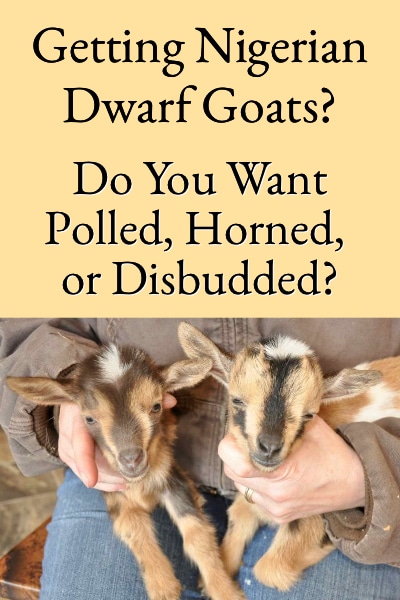
Do You Want Polled, Horned, or Disbudded Goats?
It’s not uncommon for owners of meat and fiber goats to let the horns remain; however, dairy goat owner often choose to have them removed. Also, most owners do not mix horned and hornless goats together because of the chance of injury to the hornless goats.
Typically, people have horns removed for a combination of the following reasons:
- Horns get stuck in things and can cause the goat to injure itself.
- Goats with horns can hurt each other during play.
- Horns can hurt people and are dangerous to work around when milking.
- Horns can damage fencing, barns, mangers, and so on.
- Dairy goat buyers tend to prefer hornless goats, so they’re worth more.
- Horns can break and a goat can bleed to death from a broken horn.
- Horned dairy goats aren’t normally allowed in goat shows
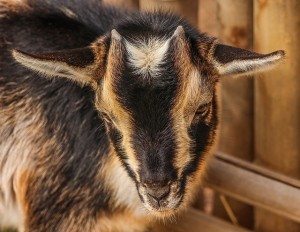
Horned Goat Kid (horns are already too large for disbudding)
Reasons for Choosing Horned
Goat owners may choose to keep horns if they’re not interested in showing and aren’t worried about the safety aspects. Also, horns do contain many blood vessels and are said to help goats regulate their temperature, particularly in hot weather. And, by keeping horns, it avoids the process of disbudding to remove them.
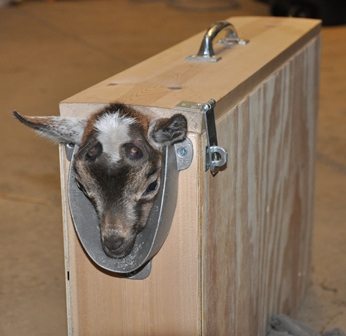
Disbudded Goat Kid in Disbudding Box
Disbudding Goats
Disbudding is often used to remove horns when goat kids are very young. It is painful to the kid for the few seconds it takes to perform the operation. The procedure is usually done when the kid is from two to ten days old, depending on when the horn bud breaks through the kid’s skull. Buck kids need to be disbudded sooner than does, and the idea is to cauterize the area surrounding the horn bud so that blood can’t flow to the horns and cause them to grow.
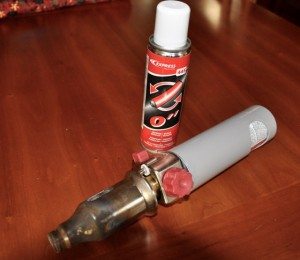
Express Gas Powered Disbudding Iron
Disbudding is performed by confining the kid in the safest way possible (it’s common to use a disbudding box like the one shown above) to hold the kid while disbudding. We found that the kids tended to thrash in the box so we now securely wrap them in a towel and simply hold them in our lap. Disbudding is accomplished by placing an extremely hot iron around the horn bud for several seconds. There are several specialty irons made specifically for this purpose (see Express Gas Powered Disbudding Iron). When properly disbudded, the horns on the kid will not continue to grow and the goat will appear to be hornless.
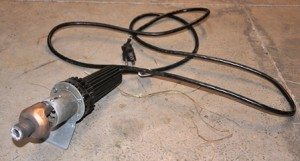
Rhinehart Electric Disbudding Iron
Polled Goats
In addition to horned and disbudded goats, there are also goats that are born polled, or naturally hornless. Although there were once many polled goats in the US (some show scorecards even awarded more points for being polled), it can be difficult to find them with great genetics today. In the mid-1940’s, the USDA published an article claiming that polled goats have an increased chance of hermaphrodism. This is an anatomical condition in which both male and female reproductive organs are present and which renders an animal sterile.
This was only one report and the statistical significance is now questionable. Nonetheless, when the article was published, breeders quickly began culling or hiding any polled genetics. So, some animals that were naturally polled were not registered as being polled, and polled animals were disbudded to disguise the fact that they were naturally hornless.
Despite the negative stigma that was attached to polled goats, there have been a few breeders over the years that have been breeding polled goats successfully and report no increase in hermaphrodism. They maintain that it’s just as likely to produce hermaphrodism when breeding horned goats as when breeding polled goats. There is still great debate on the subject; however, most goat owners detest disbudding; so polled goats are again becoming popular.
In goat DNA, there are two “slots” for horn genes and each goat gets one slot filled by its dam and one slot filled by its sire. The horned gene is recessive and the polled gene is dominant. So, if a goat receives two horned genes it is homozygous horned (and appears horned), if it receives one of each it is heterozygous polled (the dominant polled gene “hides” the horned gene and it appears polled), and if it receives two polled genes it is homozygous polled (and appears polled).
Thinking about it another way (P=polled gene, H=horned gene), if the goat receives:
HH = Homozygous horned – produces horned offspring unless bred to polled mate (looks horned).
PH = Heterozygous polled – produces polled & horned offspring unless bred to homozygous polled mate (looks polled).
PP = Homozygous polled – produces polled offspring, regardless of mate (looks polled).
Some breeders believe they minimize the possibility of producing a sterile animal by never breeding a polled goat to a polled goat, whereas others don’t worry about the possibility and believe the rate of incidence is the same whether breeding polled to polled, polled to horned, or horned to horned.
Choosing Between Disbudded, Horned, or Polled
If you are buying wethers or does intended only for pets and are not planning to breed them, then you simply need to decide whether you want the goats to have horns. If going with the hornless option, then it doesn’t matter whether the goats have been disbudded or are polled, they simply won’t have horns.
However, if you are buying does that you later intend to breed, milk, or show, then the options have more implications for the future. First of all, a horned dairy goat typically cannot be shown, and it’s difficult and somewhat dangerous (think about getting hit with a horn in the eye) to work around a horned goat when milking. That often restricts new owners to choosing hornless goats.
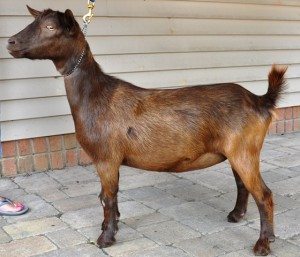
Polled Doe Calligraphy
If you are buying does that you later plan to breed and want hornless goats, then polled versus disbudded becomes a consideration. Getting a polled doe will likely minimize the amount of disbudding you or your veterinarian will need to perform over the years. But, they are still somewhat difficult to find from herds with great milk production, show, and linear appraisal credentials.
Hopefully, the information above helps you select between disbudded, horned, or polled dairy goats.
Calvingoatking says
Hello I am wondering how high off do I need the first rail and how big of gaps can I have for Nigerian dwarf goats?